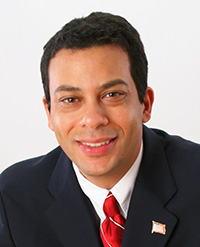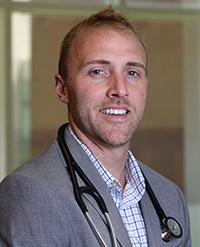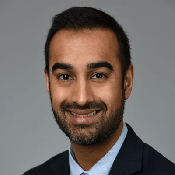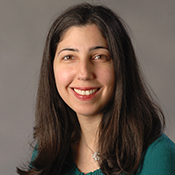Stacey Beldsoe, RN, director of diversity in clinical trials at Eli Lilly and Co., talks about the importance of addressing health equity and increasing diversity in clinical trials.
IU Lung Cancer Research
Nasser Hanna, MD, boils down the philosophy of lung cancer research at Indiana University Melvin and Bren Simon Comprehensive Cancer Center to a simple question.
 Nasser Hanna, MD
Nasser Hanna, MD“We look at the problem of lung cancer and determine what IU’s unique contributions can be,” Hanna said. “We ask, ‘What research will NOT be done if IU does not do it?’”
Hanna, who serves as the Tom and Julie Wood Foundation Professor of Lung Cancer Clinical Research at IU School of Medicine and a physician-scientist at the cancer center, leads a team of 10 clinical lung cancer researchers. Their collective goal is to conduct research that will help inform clinical decisions, such as how much chemotherapy to give a patient or whether adding immunotherapy will improve outcomes.
Currently, IU’s team is organizing their research efforts around three overarching themes: personalizing therapy for individual patients, maximizing the impact of immunotherapy in early-stage lung cancer, and overcoming resistance to platinum-based therapies. IU’s findings translate to better care for patients in Indiana and around the world. And they answer other questions as well.
Could patients with early-stage disease benefit from immunotherapy?
 Greg Durm, MD
Greg Durm, MDIn the past seven decades, treating patients with Stage I non-small cell lung cancer has been straightforward: surgery. Countless studies showed that chemotherapy after surgery made little difference. Today, that entrenched thinking means those patients—who make up most of the new lung cancer cases—are locked out of trials exploring whether immunotherapy boosts survival rates. And while surgery cures many of these patients, up to 35 percent see their disease return.
Greg Durm, MD, an assistant professor of clinical medicine at IU, wants to know if immunotherapy will benefit these patients. He is launching a clinical trial enrolling 368 patients at more than a dozen clinical sites in the Big Ten Cancer Research Consortium. Those receiving an immunotherapy drug will undergo periodic blood and imaging tests to monitor their disease. This trial–the largest study ever conducted through the prestigious Big Ten consortium–could set a new standard of care for oncologists across the globe.
Can we use a biomarker to tailor how long a patient needs treatment?
 Melissa Yan, MD
Melissa Yan, MD Nikhil Shukla, MD
Nikhil Shukla, MDOnce patients undergo surgery to remove lung cancer, the year that follows can be a long slog. Over those 12 months, patients receive additional therapy to keep the disease at bay. For some, this entails four rounds of chemotherapy and immunotherapy. Others require extra doses of immunotherapy. Sadly, some patients see no benefit from this additional treatment.
IU clinicians want to use circulating tumor DNA to customize and shorten therapy. Their goal is to use a blood test to detect faint traces of the DNA from lung cancer tumors drifting through a patient’s body. This indicates that patients still have cancer–even if it’s not detectable on scans. When that DNA is no longer in the bloodstream, patients can be deemed cancer-free and spared additional, unnecessary treatment.
IU’s scientists are using circulating tumor DNA to pave a path toward tailored therapy. For example, Melissa Yan, MD, measures how long it takes patients receiving chemotherapy and immunotherapy to clear that DNA from their bloodstreams. Beyond validating the biomarker, oncologists could use her findings to better understand how long they should prescribe treatment to people with Stage I to Stage III non-small cell lung cancer.
Nikhil Shukla, MD, is also using circulating tumor DNA to personalize treatment. In his clinical trial, patients free of the biomarker after two tests wouldn’t receive additional immunotherapy. Meanwhile, patients with detectable levels of circulating DNA continue receiving treatment until they achieve a pair of clean tests. Ideally, some people would see their treatment shaved in half, avoiding side-effects that affect quality of life.
What role can precision genomics play in sensitizing cancer to chemotherapy?
 John Turchi, PhD
John Turchi, PhD Shadia Jalal, MD
Shadia Jalal, MDThe goal of chemotherapy is to damage the DNA of lung cancer cells, undercutting their ability to divide and increase. Unfortunately, lung cancer is wily. To circumvent the treatments, the disease activates molecular processes to fix what chemo tries to break.
In his lab, John Turchi, PhD, the Tom and Julie Wood Foundation Professor of Lung Cancer Research at IU School of Medicine and a researcher at the cancer center, studies these DNA repair pathways and has developed an oral drug that could re-sensitize lung cancer cells to chemotherapy. After the drug showed promise in animal models, Turchi licensed it to an outside drug company to expedite its development for human trials.
Meanwhile, Shadia Jalal, MD, an associate professor of medicine, is also leveraging IU’s expertise in DNA repair and precision genomics. Under her plan, a sample of a patient’s tumor would be analyzed, revealing genetic mutations that help lung cancer hijack pathways and heal itself. Even better, an existing drug could be prescribed to block it. She is working with several pharmaceutical companies to obtain drugs at no cost. The IU Simon Comprehensive Cancer Center possesses the infrastructure and experience to get such a trial off the ground. Over time, the trial would expand as Jalal identifies more mutations and drug combinations.
While their progress is encouraging, the IU research team knows there is so much more left to do. Despite improved survival rates, only one in five lung cancer patients lives five years beyond their diagnosis. Hoosiers remain especially at risk, experiencing the disease at a rate higher than the national average. They’re also dying from it at a rate 18 percent higher than other patients across the country.
Lung Cancer Research Headlines
Nov. 2024: Lung cancer research saves lives: How clinical trials advance understanding and survivorship
Aug. 2024: VA funds IU School of Medicine research projects relevant to veterans' health
Mar. 2024: IU Simon Comprehensive Cancer Center to establish new lung cancer research center with $20M gift




